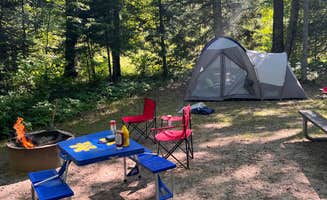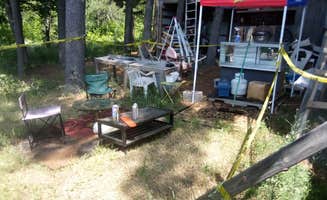Tent camping around Indian River, Michigan offers varied terrain across state forest lands with elevations ranging from 600-1,200 feet. The region experiences distinct seasonal changes with summer temperatures averaging 75-85°F during day and 55-65°F at night. Most dispersed camping areas remain open year-round while established sites typically operate April through November with varying access limitations during winter months.
What to do
Swimming at Ocqueoc Falls: The falls area provides a natural swimming hole during summer months. According to Laura, "Walk along the Ocqueoc River to the falls, walk the path through the campground or park at the site and take a short trip to the falls." The falls are Michigan's largest in the Lower Peninsula and remain the state's only universally accessible waterfall.
Hiking trail networks: Ocqueoc Falls State Forest Campground connects to extensive hiking trails. Sarah B. notes, "Short drive to other attractions in the area, with swimming and hiking in your backyard." The trail system includes shorter loops for casual hikers and longer options spanning forest and riverside terrain.
Horseback riding: Elk Hill Equestrian River Trail Campground provides dedicated equestrian facilities. Devora D. reports, "This is a great horse camp. Have camped here many times. Pump water and river for horses. Manuer bunkers and solid poles for highline tying." The campground connects to designated horse trails through Pigeon River Country State Forest.
Kayaking access: The region offers numerous river paddling opportunities with convenient launch points. Sue R. from Sturgeon Valley Campground states, "River access great. My favorite place to camp and kayak." Multiple rivers including the Sturgeon, Pigeon, and Black provide paddling routes ranging from 2-15 miles with varying difficulty levels.
What campers like
Natural swimming opportunities: The shallow pools and small cascades create family-friendly water features. Joshua M. explains, "Overall a terrific spot for rustic camping that's easy to access and within easy distance to travel to all the area's offerings." The swimming areas maintain adequate depth even during drier late summer months.
Wooded privacy: Many sites provide natural separation through forest vegetation. Sarah B. shares, "Lots of space and wooded areas around you, good spots for hanging out in the hammocks, a private swimming hole in the river." Most tent sites offer shade coverage with filtered sunlight rather than direct exposure.
Fall colors: The hardwood forests display peak autumn colors typically from late September through mid-October. "In autumn the ice and leaves are amazing," notes Sarah from Ocqueoc Falls State Forest Campground. The mixed northern hardwood forests feature sugar maple, beech, and yellow birch creating diverse fall color patterns.
Limited crowding: Compared to more developed camping regions, the Indian River area maintains a quieter atmosphere. Joshua M. observes, "The lack of big rigs makes for a generally laid back and quiet atmosphere - a certain plus." Weekday camping, even during summer, often provides near-solitude at many locations.
What you should know
Variable cell coverage: Connectivity remains inconsistent throughout the region. Maria L. reports, "Cell service is iffy… a bar or two on a good day if you have Verizon, likely not with any of the other providers." Coverage improves at higher elevations with Verizon typically providing the best regional service.
First-come, first-served system: Most state forest campgrounds do not accept reservations. According to Laura, "[Ocqueoc Falls has] first come first serve sites, a well with pump for water and clean vault toilets." Arriving mid-week or before noon on weekends improves site selection opportunities.
Carry-in requirements: Some sites require hauling gear from parking areas. Doug B. explains about Pinney Bridge, "This campground is hike in/walk in only. The closest parking space is 700 yards and 50 feet in elevation lower than the campground." Pack accordingly with collapsible containers and lightweight gear when selecting walk-in sites.
Limited amenities: Facilities remain basic throughout most camping areas. Rachel K. notes about Ocqueoc Falls, "Picnic table, hand pump water, and a clean outhouse. It's got what you need." Most sites provide vault toilets cleaned regularly but no shower facilities or electrical hookups.
Tips for camping with families
Accessible waterfall options: The Ocqueoc Falls provides handicap-accessible water features. Jayne W. notes, "Ocqueoc falls, which is a handicap accessible water fall in northern Michigan, it is very nice, lots of the sites are on the river, it's a beautiful area." The falls include paved pathways and accessible viewing platforms.
Swimming depth considerations: Water levels affect swimming conditions throughout the season. Amber A. advises, "Multilevel falls where you can swim. Many places to walk/hike, picnic, and enjoy the views. Beautiful overall with nice wooded campsites, some right next to water. Some poison ivy near our site a few years ago, watch your kids."
Alternative camping options: C3 farm trust offers private camping with basic amenities. Jake C. states, "Private tent camping in rural michigan." These private options sometimes provide more predictable availability when state forest campgrounds fill during peak periods.
Proximity planning: Select camping locations based on daily activity plans. Christopher P. from Stoney Creek Trail Camp suggests, "Nice little metro park for tent camping. Most sites are dispersed. You can pull your car up to the site for unpacking." Using centrally-located base camps minimizes travel time between activities.
Tips from RVers
Size restrictions: Many forest roads and campgrounds cannot accommodate larger recreational vehicles. Joshua M. observes, "We fit our small travel trailer easily into a fairly level lot. The lack of big rigs makes for a generally laid back and quiet atmosphere." Most state forest campgrounds limit RV length to 20-25 feet maximum.
Limited hookups: Prepare for self-contained camping without electrical or water connections. Rachel K. explains about Ocqueoc Falls, "It's not a bad site, rather small, kinda felt crowded even when it wasn't." Generators are generally prohibited in state forest campgrounds, requiring battery or solar power systems.
Level site challenges: Natural camping surfaces often require leveling equipment. Joshua M. notes finding "a fairly level lot" at Ocqueoc Falls, but this varies by site. Carrying additional leveling blocks helps address the uneven terrain common throughout the region's tent camping areas.



